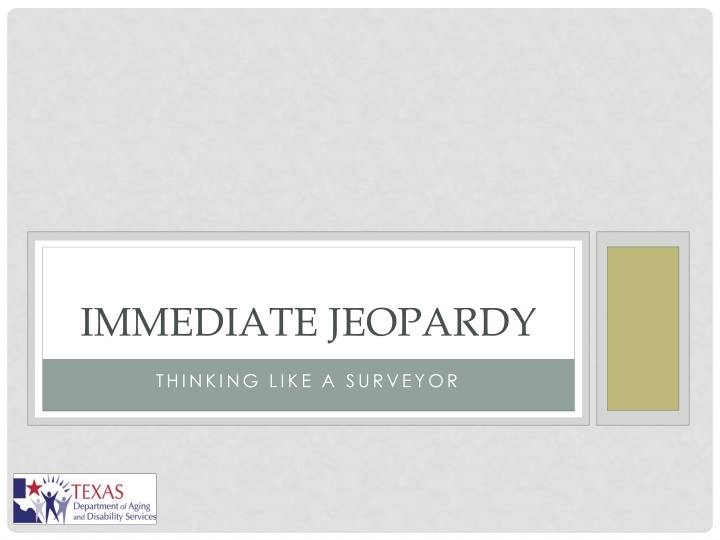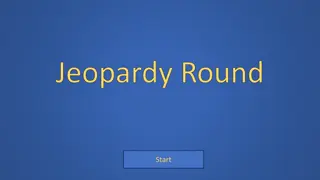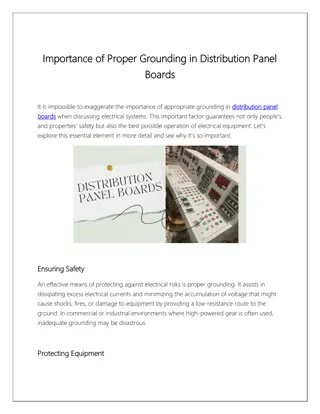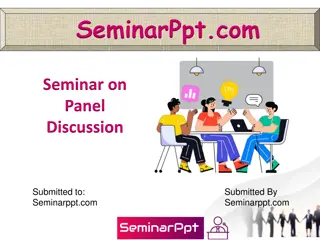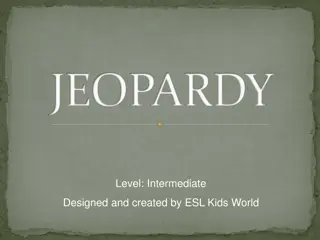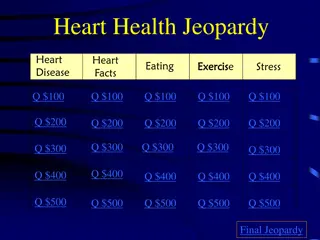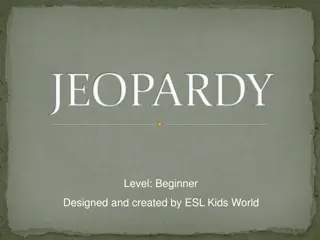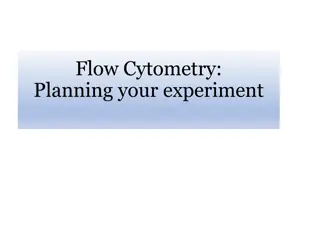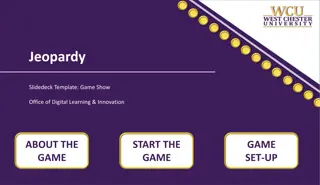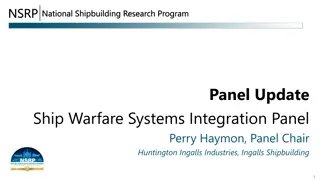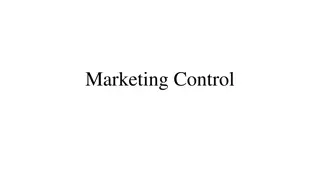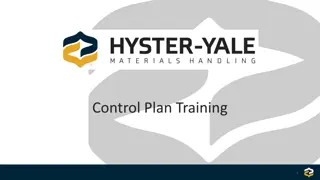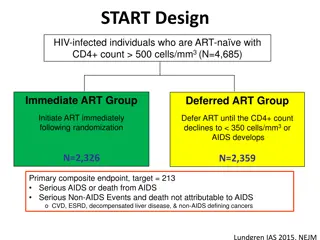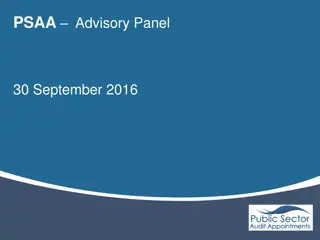Immediate Jeopardy Control Panel Access
Quickly navigate your control panel, access audio features, and think like a surveyor with the immediate jeopardy function integrated into the system. Utilize audio PIN for telephone access and adapt panel visibility to suit your needs.
Download Presentation

Please find below an Image/Link to download the presentation.
The content on the website is provided AS IS for your information and personal use only. It may not be sold, licensed, or shared on other websites without obtaining consent from the author.If you encounter any issues during the download, it is possible that the publisher has removed the file from their server.
You are allowed to download the files provided on this website for personal or commercial use, subject to the condition that they are used lawfully. All files are the property of their respective owners.
The content on the website is provided AS IS for your information and personal use only. It may not be sold, licensed, or shared on other websites without obtaining consent from the author.
E N D
Presentation Transcript
IMMEDIATE JEOPARDY THINKING LIKE A SURVEYOR
YOUR CONTROL PANEL Make panel appear or disappear
YOUR CONTROL PANEL Make panel appear or disappear xxx xxx xxxx xxxxxxxxxx Audio PIN Choose Telephone Dial in and enter access code Enter Audio PIN
YOUR CONTROL PANEL Make panel appear or disappear xxx xxx xxxx xxxxxxxxxx Audio PIN Raise your hand if you can hear me. Click this button!
YOUR CONTROL PANEL Enlarge the webinar window to full screen xxx xxx xxxx xxxxxxxxxx Audio PIN Chat box for asking questions or conveying comments
IMMEDIATE JEOPARDY THINKING LIKE A SURVEYOR
Surveyor ? How many of you would like to know what Surveyors are thinking when they enter your facility to conduct a survey?
INTRODUCTION Focus of this presentation includes: Immediate Jeopardy (IJ); Triggers; Determining Factors; Decision Making; Avoiding an IJ; and Removing an IJ.
THE GOAL Today, you will: explore the ramifications of an Immediate Jeopardy (IJ) being called in your facility; consider ways to avoid having an IJ called; and review steps to take if an IJ is called in your facility.
APPENDIX Q Find Appendix Q at: https://www.cms.gov/Regulation s-and-Guidance/Guidance/ Manuals/ downloads/som107 ap_q_immedjeopardy.pdf The State Operations Manual (SOM) is available at: https://www.cms.gov/Regulation s-and-Guidance/Guidance/ Manuals/Internet-Only-Manuals- IOMs-Items/CMS1201984.html
REQUIREMENTS OF PARTICIPATION
REQUIREMENTS OF PARTICIPATION Requirements of Participation refer to a broad range of topics.
REQUIREMENTS OF PARTICIPATION a situation in which the provider's noncompliance with one or more requirements of participation has caused, or is likely to cause, serious injury, harm, impairment or death to a resident or patient Immediate Jeopardy 42 CFR Part 489.3 Appendix Q, Section II
REQUIREMENTS OF PARTICIPATION An IJ is a form of noncompliance that is especially serious. When an IJ is called, "The threat of probable harm is real and important and could be perceived as something that will result in potentially severe temporary or permanent injury, disability, or death." (SOM 3010A)
POSSIBLE CAUSES People In your facility, who could be responsible for an IJ?
POSSIBLE CAUSES Individuals must not be subjected to abuse by anyone including, but not limited to, entity staff, consultants or volunteers, family members or visitors. Appendix Q, Section III
POSSIBLE CAUSES A failure in one or more of these areas usually causes most IJs: managing operations and staff; planning delivery of services; implementing care plans correctly;
POSSIBLE CAUSES How might managing operations and/or Staff fail to comply with the Requirements of Participation? A. failing to conduct a background check on a new Employee B. running out of time-sensitive medications before they are delivered C. not providing specialized care and services to Residents D. All of the above. Poll Question
POSSIBLE CAUSES More areas where failures occur that could cause IJs are: monitoring and evaluating staff performance; ensuring contractors honor their contracts ; or ensuring staff s knowledge base is current or updated.
POSSIBLE CAUSES Case Study #1 On 9/3/15, staff determined that Lucille was at high risk for pressure ulcers. On 12/29/15, Lucille fractured her right leg. At the hospital an immobilizer was placed on her leg from her knee to the ankle.
POSSIBLE CAUSES Case Study #1 Lucille s 1/3/16 care plan identified skin breakdown as a problem and stated, Check under immobilizer brace every shift for breakdown. On 1/4/16, her physician ordered a weekly skin assessment for Lucille. However, from 1/4/16 until 1/20/16, staff only checked Lucille s exposed skin around the edges of the immobilizer.
POSSIBLE CAUSES Case Study #1 On 1/21/16, an orthopedic physician removed the immobilizer and discovered a Stage IV pressure ulcer on Lucille s Achilles tendon and above her right ankle. http://ts1.mm.bing.net/th?id=JN.8yR2AN0%2b5j9K9XnL9MzZuww=300h=300c=0pid=1.9rs=0p=0 pressure ulcer
POSSIBLE CAUSES Chat Given only the information we have here, what questions do you think the Surveyor would ask? Question
POSSIBLE CAUSES Chat How could the facility have prevented this situation from being called an IJ? Question (follow up)
POSSIBLE CAUSES Unexpected Changes Unexpected changes that could contribute to an IJ include but are not limited to: a Resident accidentally falling when walking to the dining room; management changing a policy and failing effectively to monitor staff; and two roommates who previously got along starting to curse at and hit each other.
POSSIBLE CAUSES Chat What other examples of unexpected changes can you think of? Question
POSSIBLE CAUSES A Resident accidentally falls when walking to the dining room.
POSSIBLE CAUSES meriting condemnation or blame esp. as wrong or harmful syn. blameworthy culpable Webster s Ninth New Collegiate Dictionary 1989
PRINCIPLES OF IJ One Person A condition could exist that threatens many Residents, or just one. One person is the extent by which protection is measured for all Residents in similar situations. Appendix Q, Section III
PRINCIPLES OF IJ High Potential Serious harm, injury, impairment and/or death do not actually have to occur before a Surveyor will consider calling an IJ. If conditions exist with a high potential for these outcomes to occur in the very near future, these conditions could be regarded as a component of an Immediate Jeopardy.
PRINCIPLES OF IJ Universal Protection Residents must not be subjected to abuse by anyone including, but not limited to: entity Staff; Consultants or Volunteers; other Residents; Family Members; or Visitors.
PRINCIPLES OF IJ Nature of Serious Harm Serious harm can result from both abuse and neglect.
PRINCIPLES OF IJ Nature of Psychological Harm Psychological harm can be as serious as physical harm.
PRINCIPLES OF IJ Neglect Neglect is failure to provide a Resident the care and services necessary to avoid physical harm, mental anguish or mental illness.
PRINCIPLES OF IJ failure to provide goods and services necessary to avoid physical harm, mental anguish, or mental illness neglect (42 CFR Part 488.301) (Appendix PP, F224)
PRINCIPLES OF IJ Neglect should be considered an Immediate Jeopardy because A. some Residents are unable to protect themselves. B. it could be a potentially dangerous situation. C. the Staff must learn the full ramifications of neglect. Poll Question
PRINCIPLES OF IJ willful infliction of injury, unreasonable confinement, intimidation, or punishment with resulting physical harm, pain, or mental anguish abuse (42 CFR Part 488.301) (Appendix PP, F223)
IJ PARAMETERS a situation in which the provider's noncompliance with one or more requirements of participation has caused, or is likely to cause, serious injury, harm, impairment or death to a resident Immediate Jeopardy 42 CFR Part 489.3 Appendix Q, Section II
IJ PARAMETERS The serious harm, injury, impairment or death may have occurred in the past, may be occurring at present, or may be likely to occur in the very near future as a result of the jeopardy situation.
IJ PARAMETERS After determining that a situation is harmful, the Surveyor(s) will consider the following points regarding the entity s compliance: The entity either created a situation or allowed a situation to continue which resulted in serious harm or a potential for serious harm, injury, impairment or death to individuals. The entity had an opportunity to implement corrective or preventive measures.
IJ PARAMETERS If a Surveyor(s) recognizes a situation that may constitute IJ, he/she must investigate the condition until he/she confirms or rules out the immediacy of the situation and whether the facility is culpable. interview record review observation
TRIGGERS Issues a. protect from abuse; b. prevent neglect; c. protect from psychological harm; d. protect from undue adverse medication consequences and/or failure to provide medications as prescribed; Failure to
TRIGGERS Issues e. provide adequate nutrition and hydration to support and maintain health; f. protect from widespread nosocomial infections; g. correctly identify individuals; i. provide safety from fire, smoke and environment hazards and/or failure to educate staff in handling emergency situations. Failure to
